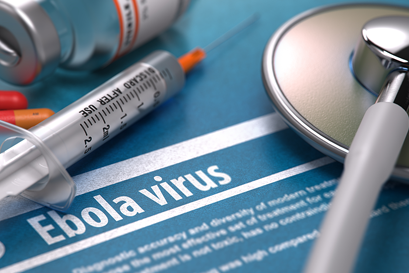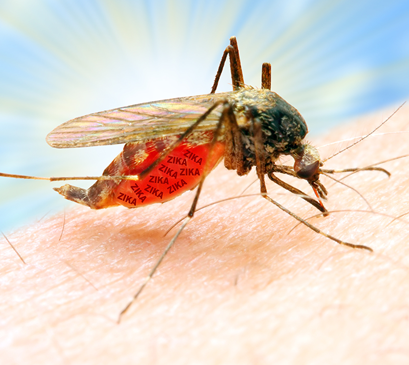Emerging Infectious Diseases
Flu (Influenza)
What Is Flu (Influenza)?
Flu, or influenza, is a contagious illness caused by a flu virus. It attacks the nose, throat and lungs in people. Anyone, including healthy people, can get the flu. Serious health problems from the flu can happen at any age.
What Are The Types Of Flu Viruses?
There are three types of flu viruses: A, B, and C. Influenza type A viruses can infect people, birds, pigs, horses, seals, whales and other animals. Wild birds are the natural hosts for these viruses. Influenza B viruses are usually found only in humans. Influenza type C viruses cause mild illness in people.
For more information, call the San Bernardino County – Department of Public Health at 1 (800) 782-4264.

How Are Seasonal Flu, Avian Influenza (Bird Flu) And Pandemic Flu Different?
Seasonal flu follows predictable yearly patterns, generally from October through March. Viruses associated with seasonal flu include influenza A, influenza B and influenza C. People usually have some immunity built up from previous exposure to circulating seasonal flu viruses.
Avian influenza (bird flu) is an infection caused by bird flu viruses. These bird flu viruses occur naturally among birds worldwide. Rarely, transmission is possible from sick or dead birds to people.
A pandemic is a global disease outbreak. A flu pandemic is possible when an influenza A virus makes a dramatic change that results in a new or novel virus to which people have little or no immunity. The new virus then begins to cause serious illness, spreads easily from person to person and can sweep around the world quickly.
How Do You Get The Flu?
Flu is very contagious. It can be caught from breathing in droplets in the air from someone sneezing, coughing or talking. The flu also is spread when people touch something with the flu viruses on it such as a doorknob or handrail, and then touches their eyes, nose or mouth. People can spread flu from one day before symptoms appear to seven days after symptoms go away.
What Are The Symptoms Of Flu?
Symptoms of flu come on suddenly, one to four days after the virus enters the body. These symptoms include:
- Sudden fever (100.4 degrees Fahrenheit or more)
- Headache
- Tiredness, sometimes extreme
- Dry cough
- Sore throat
- Nasal congestion
- Body aches
Children also may have an ear infection, nausea or vomiting. Young children with flu can develop high fevers and seizures. Generally, people start feeling better after the body’s temperature returns to normal, in about three days, and are ready to return to their normal activities in about a week. Tiredness and a cough may linger for several more weeks.
What Are Some Complications From The Flu?
In people with chronic medical conditions such as heart or lung disease, kidney disease or diabetes, flu can lead to pneumonia and other life-threatening illnesses. Others at higher risk of complications include those with weakened immune systems, the elderly, the very young and pregnant women.
How Is Flu Treated?
Four antiviral medicines – amantadine (Symmetrel©), rimantadine (Flumadine©), oseltamivir (Tamiflu©) and zanamivir (Relenza©) – are approved by the U.S. Food and Drug Administration for treating flu. All four usually work against influenza A viruses. However, the drugs may not always work because flu virus strains can become resistant to one or more of these medicines. To be effective, antivirals should be taken within 48 hours of the beginning of symptoms. Antivirals do not cure the flu.
How Is Flu Prevented?
Vaccination is the best way to prevent flu and its severe complications. It takes about two weeks after vaccination for a person to be fully protected. A live, weakened vaccine given as a nasal spray also is available for people 5 to 49 who are in good health and are not pregnant. A vaccine will need to be developed to match a new or novel virus strain that is transmitted person to person. Other prevention suggestions include:
- Wash your hands often, especially after being in contact with someone who has a respiratory infection or with children who get viruses easily.
- Avoid touching your eyes, nose or mouth.
- Use a tissue when you cough or sneeze, then throw the tissue away.
- Avoid close contact with those who are sick.
- Stay home if you are sick. Keep children at home if they are sick.
- Wipe surfaces such as bathroom and kitchen sinks, faucets and counters with a mixture of 1 part household bleach to 9 parts water.
- Take good care of yourself physically and emotionally.
What Is The Difference Between The Flu And A Cold?
The flu and the common cold are both respiratory illnesses, but they are caused by different viruses.
Unlike flu, the common cold comes on gradually, rarely causes fever and is usually limited to a sore throat, coughing, sneezing and a stuffy, runny nose.
In general, the flu is worse than the common cold. Symptoms such as fever, body aches, extreme tiredness and dry cough are more common and intense and come on more suddenly. Colds generally do not result in serious health problems such as pneumonia, bacterial infections or hospitalizations.
Pandemic Influenza
Pandemic Influenza (Flu) is an influenza virus that is highly pathogenic for humans, can spread easily from person to person worldwide, is genetically unique, and causes high morbidity and mortality. Pandemic influenza is caused by a new influenza virus to which there is little or no immunity in the human population. A pandemic influenza virus can infect and replicate in humans, it spreads easily and is sustained among humans.
What Would The Effects Of Phase 6 Pandemic Be On San Bernardino County?
San Bernardino County has a population of 1.9 million. Of those approximately 30% (600,000) may become infected with H5N1 and approximately 5% (30,000) of those infected may die. We are currently in a phase 3 alert stage which means there has been no or very limited human to human transmission (as determined by the World Health Organization).

What Are The Symptoms Of Pandemic Flu?
Pandemic flu symptoms resemble those of the common flu (fever, cough, sore throat, shortness of breath, eye infections, & muscle aches). Increased symptoms include pneumonia, severe respiratory diseases, and other severe and life threatening complications (multi-organ failure). The difference between common flu and pandemic flu is that patients do not get better. If you had pandemic flu you would need to see your doctor for treatment.
How Would The Department Of Public Health Intervene?
The Department of Public Health would intervene by non-medical control measures, which would include communication with the public before and during the event. Isolating cases of pandemic flu would voluntary or self-imposed shelter-in-place. People that are sick would need to stay at home. If it is necessary the Public Health Officer can mandate the isolation or quarantine of individuals. Social distancing measures may be advised or enforced, which could include: school dismissal, sending home non-essential workers, canceling mass gatherings, and limiting travel.
What Can You Do?
To prepare for Pandemic Flu you can promote public health efforts in your community & stay informed! Practicing good health habits will help reduce the risk of influenza and pandemic influenza if it occurs:
- Wash hands frequently
- Cover coughs and sneezes
- Stay at least 3 to 6 feet away from others when sick
- Continue to practicing proper handling and cooking of poultry and egg products
Planning
- Plan Now: Individual and Family Planning
- What To Expect from the Next Flu Pandemic
Business Planning
- Business Planning for Employers
- Disaster Supplies Kit for the Workplace
- Business Continuity Planning
School Planning
- Childcare and Preschool Checklist
- School District (K-12) Checklist
- College and University Checklist
Health Care Planning
- Emergency Medical Services and Medical Transport Checklist
- Home Health Care Checklist
- Hospital Checklist
- Long-term and Other Residential Facilities Checklist
- Medical Offices and Clinics
Who Do I Contact?
If you have flu symptoms and think you have been exposed to Avian Influenza during recent travel to countries where there are known human cases of the H5N1 (Avian or Bird Flu) virus call you doctor or seek medical treatment.
Seasonal Influenza (Flu)
Seasonal influenza (flu) is a contagious respiratory illness caused by influenza viruses. It can cause mild to severe illness, and at times can lead to death. There are thousands of flu viruses that are easily spread from person to person. People may have some residual immunity to the virus and a vaccine is available.
The best way to prevent the flu is to get a flu vaccine each fall. Vaccinations are recommended for people six (6) months and older. A parent or guardian must accompany children under eighteen (18) years of age. Children six (6) months – eight (8) years of age may require two (2) doses based on prior flu vaccination history. Second dose must be given four (4) weeks after the first dose.
Ebola Virus Disease (EVD)
While the risk of Ebola transmission in California is low, state and local public health officials in California are monitoring the situation very closely and have taken and will continue to take steps to keep Californians safe.
San Bernardino County Department of Public Health is working with healthcare providers, hospitals and other community partners to ensure that infectious diseases are identified quickly, laboratory testing of suspect cases is conducted, and the spread of disease does not occur.
Public Health is also working to ensure each hospital has systems and protocols in place to contain infectious diseases, and hospitals employ these precautions on a consistent basis. Public Health is emphasizing the importance of planning and testing systems for management of infectious cases in emergency departments and hospitals, including proper identification of cases and immediate isolation of the patient.

What You Need To Know About Ebola
Ebola cannot be contracted through the air, food or water. It is spread through direct contact with the blood or bodily fluids of an infected person that is showing symptoms of the virus. Direct contact means that body fluids from an infected person have touched someone’s eyes, nose, or mouth or an open cut, wound or abrasion. The virus can also be spread through exposure to certain objects (such as needles) that have been contaminated by an infected person. The virus has an incubation period of 2-21 days after a person has come into contact with the virus. Persons who do not have symptoms are not contagious.
Ebola is not spread through casual contact. Therefore, the risk of an outbreak in the U.S. is very low. Individuals who have come in direct contact with a person who is carrying Ebola and displaying symptoms of the virus are at risk, which may include health care workers caring for an Ebola patient and family and friends of infected patients.
There is currently no medication proven to cure Ebola and no vaccine available to prevent it. Treatment for Ebola is supportive, meaning providing fluids, maintaining blood pressure and replacing lost blood. Seeking health care as soon as symptoms appear increases the chances of survival. It also prevents other people from getting infected because they will not come into contact with blood and body fluids of infected people.
Zika
What Is Zika?
According to the World Health Organization, Zika virus is a mosquito-borne flavivirus. Zika virus infection is spread to people primarily through the bite of an infected mosquito (Aedes aegypti and Aedes albopictus). The illness is usually mild with symptoms lasting up to a week, and many people do not have symptoms or will have only mild symptoms.
How Is Zika Transmitted?
While Zika virus is primarily transmitted through mosquito vectors it can also be transmitted:
- From a mother to her unborn baby
- Through unprotected sex with a partner who has Zika virus disease
- Through blood transfusion with infected blood
- Through laboratory exposure and healthcare setting exposure

What Are The Symptoms And Effects Of Zika?
Many people infected with Zika virus are asymptomatic, meaning they may have no symptoms at all. For those who become sick with Zika, some of the common symptoms include:
- Conjunctivitis (red itchy eyes)
- Rash
- Fever
- Headache
- Joint/muscle pains
- Malaise
Zika virus infection during pregnancy is also a cause of serious birth defects in unborn babies and those born to mothers who become infected with the virus. Microcephaly or a small-size head and other severe fetal brain defects may occur in babies born with the Zika virus. Some women with Zika may experience miscarriage, stillbirths and spontaneous termination of their pregnancy.
Is There A Treatment?
There is no specific antiviral treatment or vaccine available for Zika virus disease. Treatment used for Zika is generally supportive and include rest, fluids, and use of pain medications (analgesics) and as well as fever medication (antipyretics).
How Can I Avoid Getting Zika?
- Prevent mosquito bites
- Plan for travel
- Check Travel Notices on places with Zika
- Avoid travelling to places where Zika is being spread by mosquitos
- Practice safe sex
- Build a Zika prevention kit
- Use bed nets
- Use condoms
- Use insect repellent
- Use Permethrin Spray
- Use Standing water treatment tablets
Where Can I Get More Information?
The following websites will provide you more information on Zika: